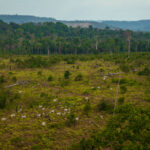Three industrial tree plantation group companies responsible for 4,700 ha forest loss in Indonesia

Just three pulp and paper companies in Indonesia were responsible for around 4,700 hectares of forest clearing during the first half of 2021, analysis by Aidenvironment shows. The figure indicates Indonesia is on its way to matching 2020’s deforestation figures, when just five companies were responsible for 13,000 hectares of forest loss. The three groups clearing the most forest in 2021 are Nusantara Fiber, Alas Kusuma and Moorim Group.
NUSANTARA FIBER
Nusantara Fiber was the largest deforester in Indonesian industrial tree plantation sector in 2020 and retained its position in the first half 2021. Aidenvironment detected approximately 2,200 hectares of deforestation from January to August 2021, with PT Industrial Forest Plantation in Central Kalimantan seeing the largest clearing (1,300 ha). The rest of the clearing was found on PT Santan Borneo Abadi and PT Bakayan Jaya Abadi in East Kalimantan.
Nusantara Fiber has been covered previously by Aidenvironment due to its high rate of deforestation, and the approximately 50,000 hectares of forest remaining on its concessions. Efforts to engage with Nusantara Fiber have not been successful. It does not have an official website and public information about the group is limited to almost non-existent. This forest, habitat of the Critically Endangered Bornean orangutan, remains at serious threat of being cleared.
Nusantara Fiber is connected to Royal Golden Eagle in various ways. RGE is committed to zero-deforestation policy at a group level, of which Nusantara Fiber is in clear violation.

Source: Planet monthly mosaics July 2021, Aidenvironment.
ALAS KUSUMA
The second largest deforester is Alas Kusuma. Alas Kusuma was also in the second rank of largest deforesters in Indonesian pulp and paper sector in 2020. From January to August 2021, Alas Kusuma cleared 1,600 hectares of forest, all detected within PT Mayawana Persada’s concession in Ketapang and North Kayong, West Kalimantan. Alas Kusuma is best known for its Forest Stewardship Council-certified plywood business in West and Central Kalimantan under the name PT Sari Bumi Kusuma and PT Suka Jaya Makmur. Alas Kusuma also has oil palm plantations in West Kalimantan, PT Sawit Jaya Makmur and PT Kusuma Alam Sari.
Alas Kusuma does not have a website, and it does not have a No Deforestation, No Peat, No Exploitation (NDPE) policy. In the latest SPOTT transparency assessment, Alas Kusuma was awarded a score in the very low ranges, just 10.6%.

Source: Planet monthly mosaics July 2021, Aidenvironment.
MOORIM GROUP
In the third rank is Moorim Group, a Korean company operating industrial tree plantations in Papua. Moorim’s subsidiary in Indonesia, PT Plasma Nutfah Marind Papua, caused 960 hectares of forest loss during the first half of 2021. Moorim does not have an explicit NDPE policy, but the company strategy outlines a commitment to conduct “eco-friendly policies in accordance with ‘Low carbon and Green growth’ policy of governments”. Moorim’s operating company in Korea holds a Forest Stewardship Council certificate for forest management. In 2020, PT Plasma Nutfah Marind involved in a social conflict with indigenous communities over a lack of compensation.
Aidenvironment has already identified Moorim Group’s practises in 2021. Our analysis showed four companies deforested 7,000 hectares of forest for industrial trees in Papua between 2016 to May 2021. Moorim was the largest deforester, having cleared 3,800 hectares of forests during this timeframe.
For more information, please contact Chris Wiggs

